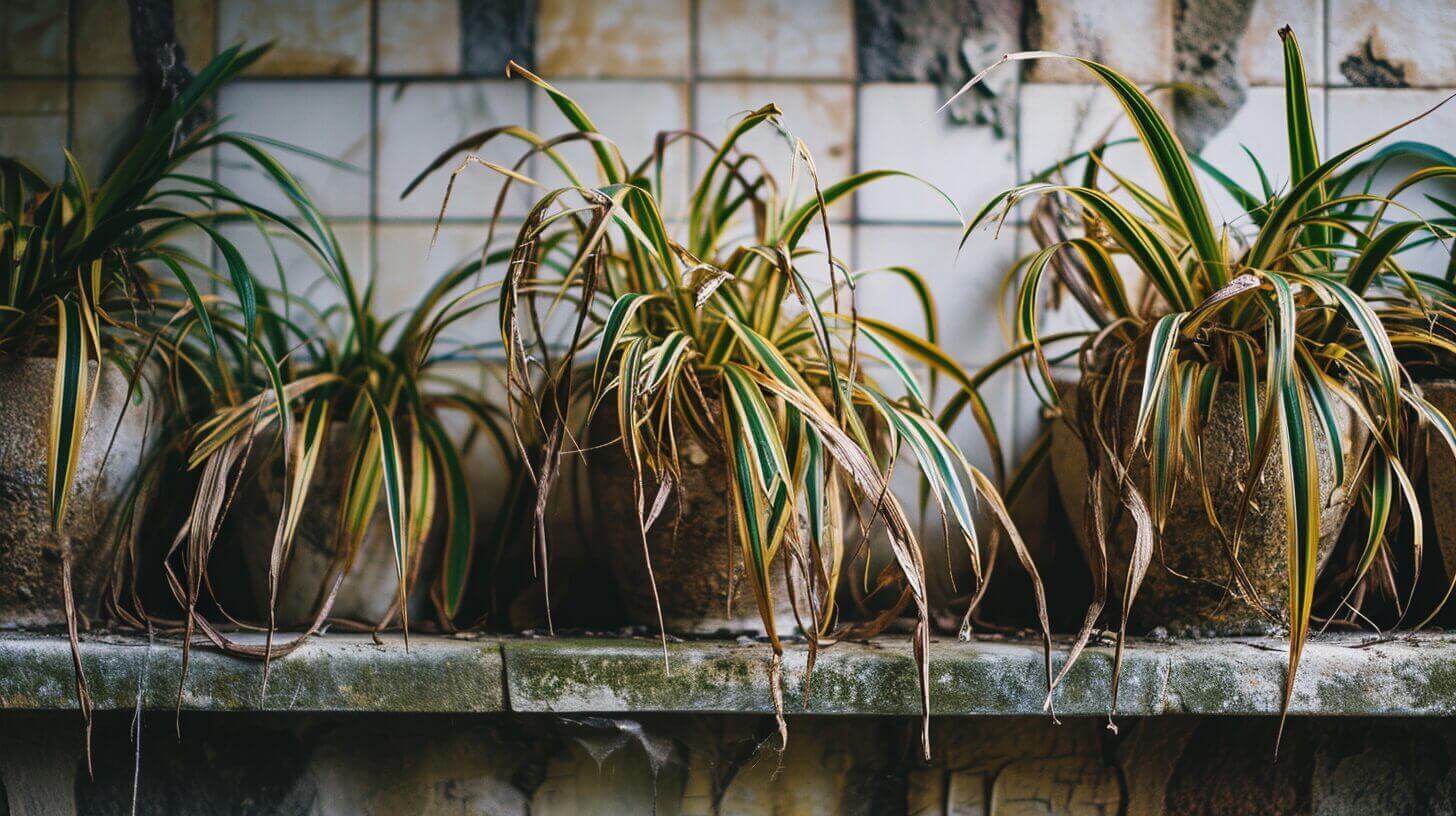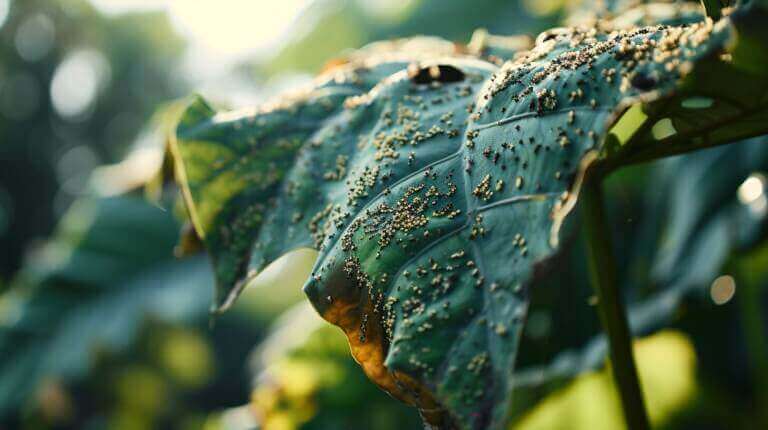This article serves as a guide, offering a lifeline to those seeking to revive their dying spider plants. Like a skilled surgeon, we will diagnose the underlying causes, administer the necessary treatments, and provide the tender care needed to bring these green companions back to life.
Key Takeaways
- Check for symptoms of decline such as wilting leaves, yellowing foliage, and stunted growth
- Inspect leaves and root system thoroughly to identify the cause of decline
- Seek professional help if symptoms are severe or uncertain
- Adjust watering and drainage to provide the right amount of moisture and prevent root rot
Assessing the Health of Your Dying Spider Plant
One must carefully assess the health of their spider plant in order to determine the necessary steps for revival. Checking symptoms is the first step in this process. Look for signs of wilting or drooping leaves, yellowing or browning foliage, or stunted growth. These symptoms can indicate various issues such as overwatering, underwatering, nutrient deficiencies, or pest infestation.
It is important to thoroughly inspect the plant, including both the leaves and the root system, to get a comprehensive understanding of its condition.
If the symptoms are severe or if you are unsure about the underlying problem, seeking professional help may be necessary. A plant expert or horticulturist can provide valuable guidance and diagnose the issues affecting your spider plant. They can offer specific remedies and suggest appropriate care techniques to revive the plant.
Identifying the Causes of Decline
To effectively address the decline of a spider plant, it is essential to identify the underlying causes responsible for its deteriorating condition. One common cause of decline is improper pruning techniques. Spider plants should be regularly pruned to remove dead or yellowing leaves and encourage new growth. When pruning, it is important to use clean and sharp tools to prevent the spread of disease.
Another cause of decline is pest infestation. Spider mites and mealybugs are common pests that can damage spider plants. Regularly inspect the plant for signs of pests, such as webbing or tiny insects, and treat them promptly with appropriate pest control methods.
By addressing these potential causes, you can begin to revive your dying spider plant.
Now, let’s move on to the next section and discuss adjusting watering and drainage.
Adjusting Watering and Drainage
Proper watering and adequate drainage are crucial for reviving a dying spider plant. To bring your spider plant back to life, follow these steps:
- Watering: Spider plants thrive in moist but well-drained soil. Check the moisture level by inserting your finger about an inch into the soil. If it feels dry, it’s time to water. Ensure you water thoroughly until it drains out of the bottom of the pot. Avoid overwatering as it can lead to root rot, which further damages the plant.
- Drainage: Spider plants dislike sitting in waterlogged soil. Make sure your pot has drainage holes to allow excess water to escape. If your plant is in a decorative pot without drainage, consider using a plastic liner or moving it to a pot with proper drainage.
- Sunlight and Pest Control: Spider plants require bright, indirect sunlight to thrive. Place them near a window where they can receive a few hours of sunlight each day. Additionally, keep an eye out for pests like spider mites or aphids. Regularly inspect the leaves and treat any infestations promptly to prevent further decline.
Providing Adequate Light and Temperature
Sufficiently providing both the right amount of light and maintaining the appropriate temperature is essential for reviving a dying spider plant. Spider plants thrive in bright, indirect light, making it crucial to ensure they receive adequate exposure to natural sunlight or artificial lighting. When it comes to natural sunlight, placing the plant near a north or east-facing window is ideal, as it provides bright but indirect light. If natural light is limited, artificial lighting can be used as an alternative. Using fluorescent lights or LED grow lights that emit a full spectrum of light can effectively mimic natural sunlight.
Additionally, maintaining a temperature range of 65-75°F (18-24°C) is recommended for spider plants to ensure optimal growth and recovery. By providing the right amount of light and maintaining the appropriate temperature, you can create a favorable environment for your dying spider plant to thrive once again.
Now that we understand the importance of light and temperature, let’s move on to implementing revival techniques and care tips to breathe new life into your spider plant.
Implementing Revival Techniques and Care Tips
By carefully following these techniques and tips, you can effectively revive your dying spider plant and ensure its healthy growth. Here are three reviving techniques and care tips to help you bring your spider plant back to life:
- Pruning: Trim away any yellow or brown leaves, as they indicate damage or disease. Cut close to the base of the plant, removing the damaged portion completely. This will encourage new growth and prevent the spread of any issues.
- Watering: Spider plants prefer well-draining soil, so make sure not to overwater them. Allow the top inch of soil to dry between waterings. When watering, pour water evenly over the soil until it drains out the bottom of the pot to ensure thorough hydration.
- Propagation: If your spider plant is severely damaged, consider propagating it. Cut healthy stems with leaves attached and place them in a container of water. Once roots appear, transfer them to a pot with fresh soil. This method allows you to salvage healthy parts of the plant and start anew.
Frequently Asked Questions
Can I Revive a Spider Plant That Has Completely Wilted and Lost All of Its Leaves?
Reviving a spider plant that has completely wilted and lost all of its leaves can be a challenging task. However, with proper care and attention, it is possible to bring it back to life.
There are several tips for reviving wilted plants, such as providing adequate water, ensuring proper drainage, providing sufficient light, and avoiding over-fertilization.
How Often Should I Fertilize My Spider Plant to Help Revive It?
When it comes to reviving a dying spider plant, fertilization plays a crucial role. However, it is important to strike the right balance. Over-fertilizing can be detrimental to the plant’s health. The frequency of fertilization depends on various factors such as the type of fertilizer used, the plant’s size, and the existing soil conditions.
It is generally recommended to fertilize spider plants every two to four weeks during the growing season. Signs of over-fertilization include yellowing leaves, burnt tips, and stunted growth.
Can I Save My Spider Plant if It Has Been Infested With Pests?
If your spider plant has been infested with pests, there are natural pest control methods that can help save it. Signs of pest infestation in spider plants include yellowing leaves, webs, and small insects on the plant.
To prevent pest infestation, ensure that the plant is kept in a well-ventilated area, avoid overwatering, and regularly inspect the plant for any signs of pests.
Natural pest control methods for spider plants include using neem oil, insecticidal soap, or introducing beneficial insects like ladybugs.
Can Reviving a Dying Spider Plant Help the Growth of Spider Plant Babies?
Reviving a dying spider plant can be a challenging task, especially when it has been overwatered or underwatered. Both of these conditions can have adverse effects on the plant’s health, causing it to wilt or develop root rot.
However, with proper care and attention, it is possible to revive a spider plant in such situations. By adjusting the watering schedule, providing adequate drainage, and ensuring proper sunlight and nutrition, the plant can gradually regain its vitality and thrive once again.
Can I Still Save My Spider Plant if It Has Been Exposed to Extreme Temperatures or Drafts for a Long Period of Time?
Saving a spider plant after prolonged exposure to extreme temperatures or drafts requires immediate action and careful care. If your spider plant has been subjected to such conditions for an extended period, it may have suffered damage, resulting in wilting or discoloration.
To revive it, start by removing it from the harsh environment and placing it in a more suitable location with indirect sunlight and consistent temperatures. Ensure proper watering, avoiding both overwatering and underwatering, and provide adequate humidity.
Regularly inspect for any signs of recovery or further deterioration and adjust your care accordingly.







